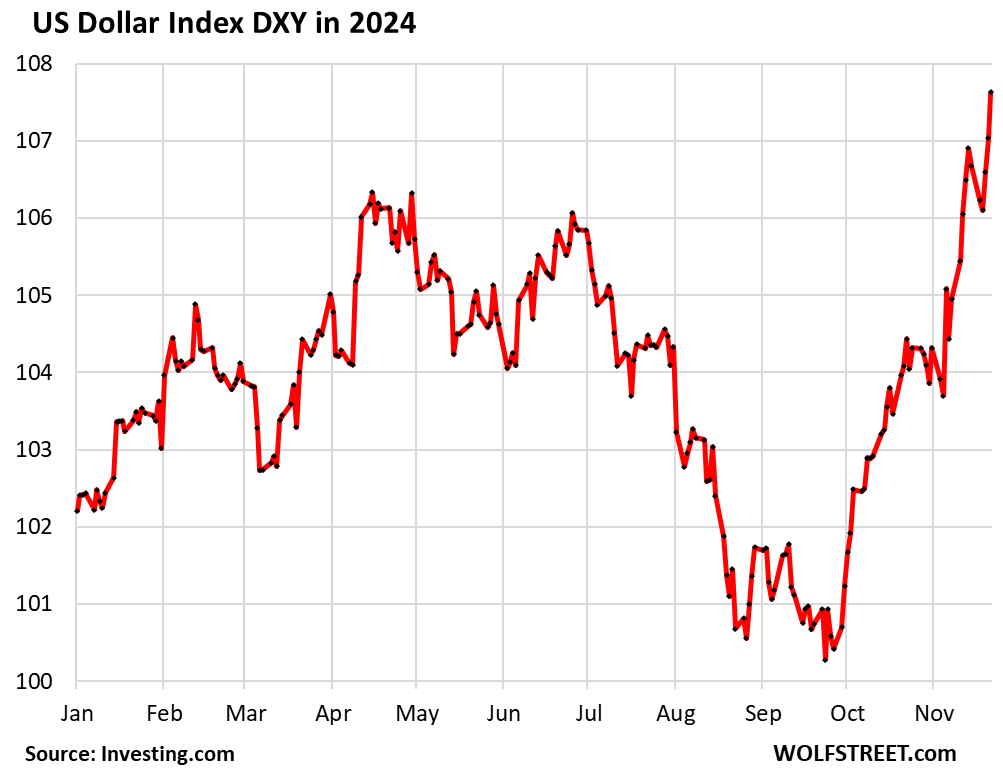The recent economic landscape has seen renewed inflation concerns coupled with above-average economic growth, as reported by Wolf Richter for WOLF STREET. The U.S. Dollar Index (DXY), which measures the value of the U.S. dollar against a basket of six major currencies, has surged to 107.6, marking its highest point in two years. This uptrend coincided with significant changes in monetary policy, particularly by the Federal Reserve (Fed), which began signaling a slowdown in the pace of interest rate cuts. Since the Fed’s large cut on September 18, the dollar has skyrocketed by 7.3%, driven by robust labor market performance and emerging signs of inflation pick-up, as consumer spending remains strong due to increased incomes and significant savings.
Despite the Fed’s cautious approach, other central banks, including the European Central Bank (ECB), Bank of Canada (BoC), and Bank of Japan (BOJ), have adopted more aggressive rate-cutting strategies. The Fed reduced its policy rate by 75 basis points to a ceiling of 4.75%, while the ECB made a more sizable reduction of 100 basis points down to 3.4%. The BoC also cut its rate by 125 basis points to 3.75%. In contrast, the BOJ only raised rates marginally from negative territory to 0.25%, indicating a reluctance to act decisively despite inflationary pressures. These divergent strategies among central banks have led to widening interest rate spreads, amplifying demand for U.S. dollar-denominated securities, further supporting the dollar’s position in the foreign exchange market.
This disparity in economic strategies has also led to noticeable declines in the values of other major currencies against the dollar. The euro, for instance, has decreased by 7% against the dollar since late September, trading at approximately $1.042, reflecting stagnation in the Euro Area economy, particularly in Germany, which has struggled with fluctuating growth metrics. Despite ongoing concerns regarding core and services inflation, the ECB has indicated it will continue to lower rates, contributing to the euro’s depreciation. Meanwhile, the Canadian dollar has faced similar challenges, weakening over the year as the BoC focused on rate cuts amid sluggish economic growth.
In Japan, the situation is particularly dire for the yen, which has plunged against the dollar despite inflation rates similar to those of the U.S. The BOJ’s cautious response to inflation, characterized by minimal adjustments to its monetary policy, has resulted in a significant depreciation of the yen, which currently trades at approximately 154.7 per dollar—trending back toward earlier lows when it touched 161.5 yen. The BOJ has engaged in interventions to prop up the yen by spending tens of billions of dollars on currency support; however, these efforts have proved only temporarily effective as the yen continues its downward trajectory.
The persistent decline of the yen reflects a two-year trend of a 30% depreciation since the Fed began adjusting rates in September 2021. As expectations solidify around higher yields on U.S. securities, foreign investors have become increasingly attracted to USD-denominated assets, further enhancing the dollar’s appeal against other currencies. Current data highlights the stark contrast in government bond yields, with U.S. 10-year Treasury yields at 4.41%, surpassing those of Canada (3.46%), Germany (2.25%), and Japan (1.08%). Such disparities underscore the factors behind the U.S. dollar’s continued strength amidst global economic shifts.
Overall, the current scenario is defined by the Fed’s cautious yet firm approach to monetary policy, contrasted with the more aggressive stances taken by other central banks grappling with inflation and economic growth. As the dollar ascends, bolstered by rising yields and investor confidence, currencies such as the euro, Canadian dollar, and especially the yen face significant pressure. With these dynamics at play, the international financial landscape is adjusting to a new normal, characterized by ongoing inflation concerns, varied growth rates, and the implications of central bank policies across leading economies. As these trends develop, market actors must remain vigilant to the evolving economic indicators that will shape future monetary strategies.

